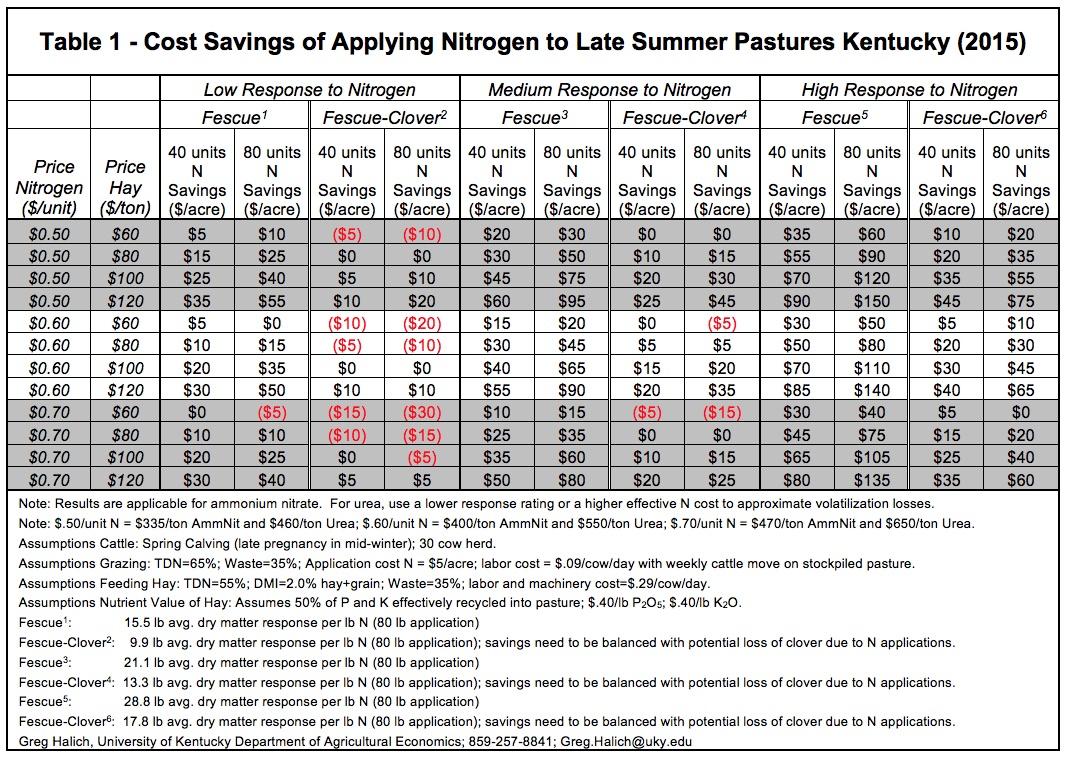Late Summer Nitrogen Application: Will It Pay in 2015?
By Greg Halich, Greg.Halich@uky.edu, 859-257-8841
We are close to the point where some livestock farmers would start to apply nitrogen to tall fescue pastures to boost production levels and stockpile for fall and winter grazing. Since there are many factors that will impact the profitability of this practice, the question at hand is: Under what set of conditions will applying nitrogen to pastures pay this year?
Soil moisture conditions are for the most part excellent right now through Kentucky, with a few exceptions. Areas with good soil moisture will have the best response to nitrogen applications. The price of nitrogen was evaluated on an elemental basis between $0.50-0.70 per unit ($335-470 per ton ammonium nitrate and $460-650 per ton urea with urease inhibitor), with application rates of 40 and 80 units/acre. Three response rates (low, medium, and high) were evaluated corresponding to various soil moisture and fertility conditions.
Farm size and management practices were assumed to be typical Kentucky conditions: 30 cow herd with late winter/early spring calving. Waste rates were estimated at 25% for both hay feeding and grazing. Forage quality was estimated at 55% TDN for hay and 65% for stockpiled fescue. Machinery and labor costs were estimated at $0.09 and $0.29 per cow-day for grazing and hay feeding respectively. P and K from the hay were assumed to be recycled back into pastures at a 50% rate at $0.40/lb for P2O5 and $0.40/lb for K2O.
Results
There appear to be good opportunities for profitable nitrogen applications in fescue stands with a low clover content (less than 15%) in areas with good soil moisture conditions. Assuming a high response rate and nitrogen priced at $0.60/unit ($550/ton urea with urease inhibitor), hay prices at or above $60/ton generated moderate to high cost savings. With the medium response rate, these stands generated a moderate to high cost savings with hay priced at or above $80/ton.
Cost savings occurred less frequently in the mixed fescue-clover stands. Assuming a high response rate, hay prices needed to be at or above $100/ton to generate moderate to high cost savings. With the medium response rate, hay prices needed to be at $120/ton to generate moderate cost savings. Additionally, any potential savings in the fescue-clover stands need to be balanced against the potential loss of clover due to N applications. As a consequence, it is advised to target pastures with the highest fescue content before considering nitrogen applications to these mixed fescue-clover stands.
As noted above, hay quality was assumed to be medium-quality, mixed hay with a 55% TDN. There is a lot of hay put up in Kentucky that has a much lower feed value. For each 5% reduction in TND (e.g. going from 55% to 50%), add $6-9/acre in cost savings for 40 unit applications and $10-15/acre for 80 unit applications. Use the lower part of this range for the medium response rate and the higher part of this range for the high response rate.
For more detailed results, consult the publication Profitability of Nitrogen Applications for Stockpiling Tall Fescue Pastures – 2015 Guide.
A publication that goes into details on the production side is AGR-162: Stockpiling for Fall and Winter Pasture.

Categories:
Fall
Extending the Grazing Season


